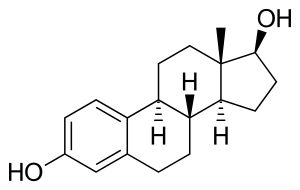Comparison of estrogens

This is a comparison of estrogens, or agonists of the estrogen receptor (ER). Estrogens include both natural estrogens like estradiol and synthetic estrogens like ethinylestradiol and diethylstilbestrol.
Pharmacodynamics
Affinities and efficacies
| Estrogen | ERα (%) | ERβ (%) |
| Estradiol | 100 | 100 |
| Estrone | 60 | 37 |
| Estriol | 14 | 21 |
| Ethinylestradiol | 190 | 11[3] |
| 17α-Estradiol | 58 | 11 |
| 4-Hydroxyestradiol | 13 | 7 |
| 2-Hydroxyestradiol | 7 | 11 |
| Estrone 3-sulfate | <1 | <1 |
| Moxestrol | 43 | 5 |
| Diethylstilbestrol | 468 | 295 |
| Hexestrol | 302 | 234 |
| Dienestrol | 223 | 404 |
| Tamoxifen | 7 | 6 |
| 4-Hydroxytamoxifen | 178 | 339 |
| Clomifene | 25 | 12 |
| Nafoxidine | 44 | 16 |
| ICI-164384 | 85 | 166 |
| 5-Androstenediol | 6 | 17 |
| 4-Androstenediol | 0.5 | 0.6 |
| 3β-Androstanediol | 3 | 7 |
| 3α-Androstanediol | 0.07 | 0.3 |
| Dehydroepiandrosterone | 0.04 | 0.07 |
| 4-Androstenedione | <0.01 | <0.01 |
| Coumestrol | 94 | 185 |
| Genistein | 5 | 36 |
| β-Zearalanol | 16 | 14 |
| Bisphenol A | 0.05 | 0.33 |
| ERα (%) | ERβ (%) | ERα (%) | ERβ (%) | |
| Estradiol | 100 | 100 | 100 | 100 |
| Estrone | 4.0 | 3.5 | 2.6 | 4.3 |
| Estriol | 11.3 | 17.6 | 10.6 | 16.6 |
| Ethinylestradiol | 233 | 37.8 | 213 | 27.2 |
| Propylpyrazoletriol | 10.0 | 0.12 | 20.0 | ND |
| 16α-LE2 | 14.6 | 0.089 | 18.9 | 0.07 |
| Diarylpropionitrile | 0.12 | 6.6 | 0.063 | 3.0 |
| 8β-VE2 | 0.35 | 22.0 | 0.11 | 34.0 |
| Fulvestrant | 9.4 | 8.3 | ND | ND |
| 4-Hydroxytamoxifen | 1.7 | 2.3 | ND | ND |
| Raloxifene | 7.8 | 0.54 | ND | ND |
| Genistein | 0.032 | 0.86 | 0.045 | 1.2 |
| Biochanin A | 0.022 | 1.2 | 0.021 | 1.0 |
| Coumestrol | 0.05 | 0.41 | 0.11 | 1.0 |
| Daidzein | 0.015 | 0.13 | 0.011 | 0.12 |
| Compound | RBA | Uterine weight (%) |
|---|---|---|
| Control | – | 100 |
| Estradiol | 100 | 506 |
| Estriol | 10 | 468 |
| 2-Hydroxyestradiol | 24 | 285 |
| 2-Methoxyestradiol | 0.05 | 101 |
| 4-Hydroxyestradiol | 45 | ? |
| 4-Methoxyestradiol | 13 | 260 |
| 2-Hydroxyestrone | 2 | 130 |
| 2-Methoxyestrone | 0.01 | ? |
| 4-Hydroxyestrone | 11 | 351 |
| 4-Methoxyestrone | 0.13 | 338 |
See also
References
- ↑ Kuhl H (2005). "Pharmacology of estrogens and progestogens: influence of different routes of administration" (PDF). Climacteric. 8 Suppl 1: 3–63. doi:10.1080/13697130500148875. PMID 16112947.
- ↑ Kuiper GG, Carlsson B, Grandien K, Enmark E, Häggblad J, Nilsson S, Gustafsson JA (1997). "Comparison of the ligand binding specificity and transcript tissue distribution of estrogen receptors alpha and beta". Endocrinology. 138 (3): 863–70. doi:10.1210/endo.138.3.4979. PMID 9048584.
- ↑ Barkhem T, Carlsson B, Nilsson Y, Enmark E, Gustafsson J, Nilsson S (1998). "Differential Response of Estrogen Receptor α and Estrogen Receptor β to Partial Estrogen Agonists/Antagonists". Molecular Pharmacology. 54 (1): 105–112. doi:10.1124/mol.54.1.105. PMID 9658195.
- ↑ Escande A, Pillon A, Servant N, Cravedi JP, Larrea F, Muhn P, Nicolas JC, Cavaillès V, Balaguer P (2006). "Evaluation of ligand selectivity using reporter cell lines stably expressing estrogen receptor alpha or beta". Biochem. Pharmacol. 71 (10): 1459–69. doi:10.1016/j.bcp.2006.02.002. PMID 16554039.
- ↑ Bhavnani BR, Nisker JA, Martin J, Aletebi F, Watson L, Milne JK (2000). "Comparison of pharmacokinetics of a conjugated equine estrogen preparation (premarin) and a synthetic mixture of estrogens (C.E.S.) in postmenopausal women". J. Soc. Gynecol. Investig. 7 (3): 175–83. doi:10.1016/s1071-5576(00)00049-6. PMID 10865186.
This article is issued from
Wikipedia.
The text is licensed under Creative Commons - Attribution - Sharealike.
Additional terms may apply for the media files.